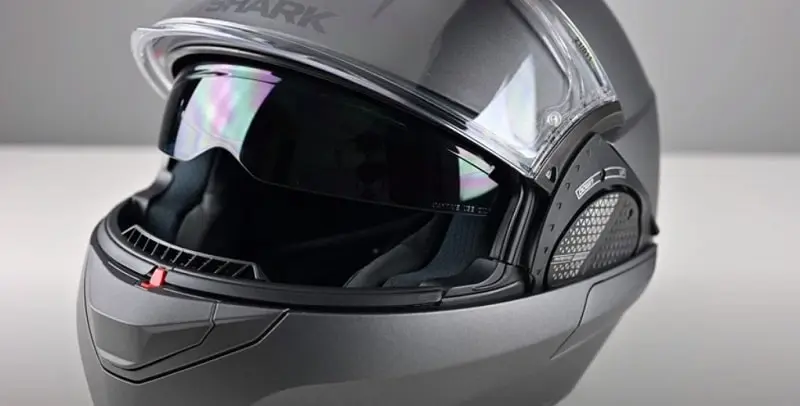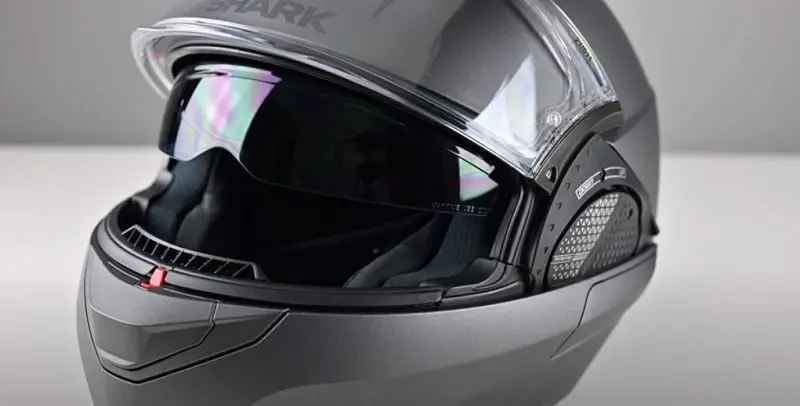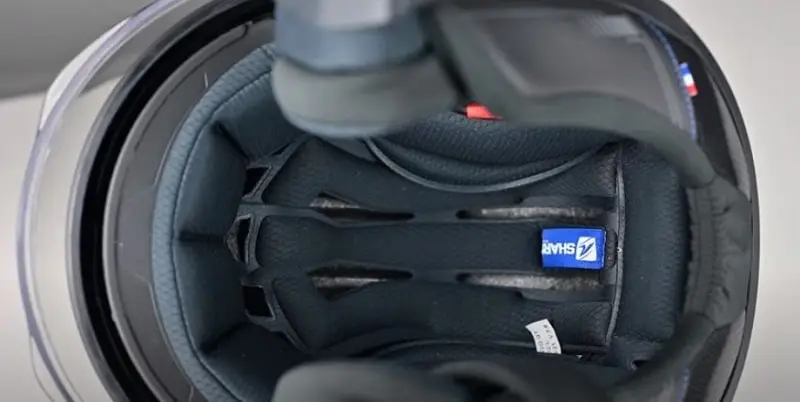Shark’s range of flip-over helmets just got one bigger with the arrival of the Evo GT.
It follows the same principle as the Evo helmets that have gone before, including the Evo ES, which continues alongside this new helmet.
The basic idea is that it’s both a full-face helmet and an open-face as the chin bar flips up and slides over to sit on the back of the shell.
This means you can have a full-face lid for hacking along on the motorway or in bad weather and an open-face helmet for the town when it’s sunny and dry.

Shark Evo GT Review
Table of Contents
Chin Bar
Squeezing the lever at the base of the chin bar lifts the visor slightly and starts the chin bar opening operation.
Then as you lift, the visor is automatically raised out of the way, and you can slide the chin bar all the way over the top of the lid.
To bring it back to the closed position, you need to pull it back slightly to release a lock, then slide it over and click it shut.
If the visor’s down when you try to slide the chin bar back over, it will automatically retract, which creates the clearance you need for the chin bar to slide past without scratching the visor.
It’s the same motion as the Evo ES, but where that helmet is aimed at commuting riders, this Evo GT is designed for touring riders.
It has a better comfort lining, improved ventilation, and a superior visor over that ES helmet.
Those upgrades do come at a price premium. The Evo GT’s launch rrp is £369.99 for plain colors and £389.99for color schemes.

Shell Construction
The shell is polycarbonate. You need to bear in mind that helmets like this are usually on the heavy side.
The medium Evo GT weighs in on our scales at 1696 grams, which is a bit on the heavy side, but it’s not as weighty as some flip helmets we’ve weighed.
Shell Sizing
It comes in just two shell sizes, so you’ve got one shell for extra small and medium and the other for large and extra large, as you would expect from this ECE 2205 certified helmet.
Ventilation

Ventilation comes through a chin vent that rocks back and forth just under the visor and two sliding switches on top, which are glove-friendly and easy to use.
Cool air flows through the scoops, and if the vents are open, it allows warm air to rise from the interior and channel back through the scoop and away.
Visor
The visor is one of the main areas that helps justify the extra outlay over the cost of the basic Evo ES.
It’s optical class 1, so the clarity is the best available, and it also has a pinlock 120 insert supplied in the box.
The anti-mist protection is much stronger than the Evo ES, which has an anti-fog coating.
It’s a max vision insert, so it covers the biggest possible area of the visor to ensure it doesn’t end up impeding your vision like some smaller Pinlock inserts can do.

Sun Visor
The outer visor works in tandem with an internal sun visor, which operates on a sliding mechanism on top of the shell.
It’s a Shark trait that they don’t use an anti-fog coating on their sun visors, and it’s the same with this helmet.
In my opinion, they would benefit from introducing that on their helmets, especially when they cost circa £400 like this one.
Interior
The interior has an anti-microbial aegis liner that’s soft and comfortable over distance, and it’s treated to stay fresh when other linings are getting quite whiffy.
There’s also a feature with this helmet that I’ve never seen before; the Evo GT comes with a second pair of cheek pads in the box.
The standard pads are 15 millimeters thick, and these accessory options are 25 millimeters thick.
So, if the lid is loose in its standard trim, you can replace the pads to give your face a little bit more support.
They also secure into the lid with velcro, so they’re probably the easiest cheek pads to fit that I can remember from any helmet I’ve tried.

Intercom

Behind those cheek pads, there are recesses for intercom speakers.
There’s also a cavity at the rear between the EPS and the shell where you can tuck the battery from a Shark tooth intercom if you go for the Shark’s official unit.
Safety Strap
The strap to secure the lid is a micrometric sliding buckle setup, which is in keeping with most helmets designed for touring.
Safety Ratings
The approvals on the Evo GT are ECE 2205 for the road. It’s rated as what they call PJ, so it’s approved for use as either a full-face helmet or an open-face helmet.
It’s not approved by the ACU for the track or racing, though I suspect that no one in their right mind would consider this a track lid.
It’s also not yet rated by the UK government’s Sharp scheme, which puts helmets through impact tests and gives them a star rating based on the results.
When I wore this lid, I found it an improvement on the Evo ES model in terms of the ease of using those top vents and the anti-mist protection on the visor with a pin lock rather than a coating.
It’s a shame the sun visor isn’t anti-mist, though convertible helmets like this are handy if you’re out on a trip combining motorways and city riding.
Or, if when you get to your destination, you’re trickling around and enjoying the sights.
This Evo GT is a good option in that market and a bit better than Shark’s alternative.
In Conclusion
The Shark Evo GT is a high-performance motorcycle helmet with a unique flip-up feature.
The helmet’s injected thermoplastic resin shell construction and dual homologation for use in both open and closed positions provide optimal protection from impacts.
The helmet’s integrated UV380 anti-scratch internal sun visor provides optimal protection from the sun, and its Pinlock 120 insert included with the helmet is compatible with other Shark helmets.
The helmet’s optimized chin guard locking system provides better ergonomics and flexibility during use, and its removable and washable lining is made to keep the interior clean and fresh.
Where To Buy
| Model | Sports Bike Shop |
|---|---|
| Shark Evo GT | From £379 |


